
The shade is welcomed on a trail near Los Feliz Boulevard and Fern Dell Drive at Griffith Park.
(Cheryl A. Guerrero / Los Angeles Times)
Too hot to hike? Try these 14 SoCal trails filled with glorious shade
- Share via
Hiking when it’s hot can be miserable, even when you carry lots of water. Few trails are completely sun-free, but these 14 offer you a shot at that rare SoCal commodity: shade. Oaks, sycamores and sometimes willows line these routes that are short but oh so chill.
Planning your weekend?
Stay up to date on the best things to do, see and eat in L.A.
Some warm-weather pointers: Start early to avoid the harshest heat of the day, bring plenty of water and sunscreen, and enjoy the trees (some have benches where you can linger) on these shady paths from Northridge to Long Beach.
Showing Places
Fern Dell in Griffith Park
Urban Trail
0.5-mile out-and-back
Easy
Flat
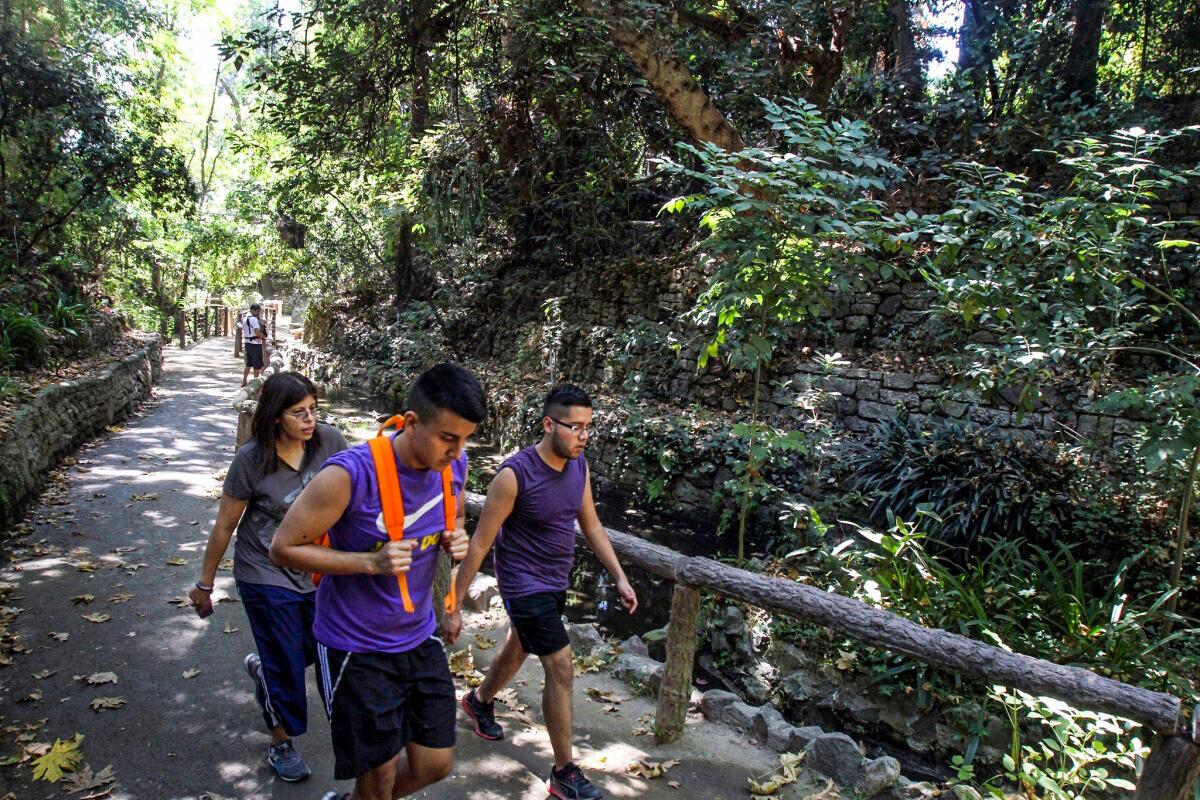
(Cheryl A. Guerrero / Los Angeles Times)
You’ll never lose your cool in beloved 20-acre Fern Dell, a part of Griffith Park. You walk beneath mature Western sycamores, alders, spruces, coastal live oaks, coastal redwoods, California bay and pines that shade the easy quarter-mile path. But there’s more. The ferns — some California natives, some exotics — and tropical plants such as elephant ear add to the greenery that makes this a spot like no other in Los Angeles.
It was officially named the Fern Dell Nature Museum, the “museum” being the wondrous plants. In the early 20th century, water from the canyon’s natural spring were thought to be healing. That began the addition of rustic touches, such as cement banisters (made to resemble wood) in the grotto and mortar-less stone walls.
The green oasis can be crowded, especially on weekends, so arrive early. Begin at Los Feliz Boulevard and Fern Dell Drive, following the path behind the Griffith Park sign and statue of a bear cub. The main paved walkway is short; feel free to explore the side trails.
If you want a longer hike, take the exposed dirt path that leads to a loop route up to the Griffith Observatory. The shade gives out on the 2.5-mile route with 613 feet of gain. If not, turn left at a pair of bridges, arrive at the Fern Dell grotto and retrace your steps. Check out the L.A. Times guide to the wild, classic and hidden gems of Griffith Park.
It was officially named the Fern Dell Nature Museum, the “museum” being the wondrous plants. In the early 20th century, water from the canyon’s natural spring were thought to be healing. That began the addition of rustic touches, such as cement banisters (made to resemble wood) in the grotto and mortar-less stone walls.
The green oasis can be crowded, especially on weekends, so arrive early. Begin at Los Feliz Boulevard and Fern Dell Drive, following the path behind the Griffith Park sign and statue of a bear cub. The main paved walkway is short; feel free to explore the side trails.
If you want a longer hike, take the exposed dirt path that leads to a loop route up to the Griffith Observatory. The shade gives out on the 2.5-mile route with 613 feet of gain. If not, turn left at a pair of bridges, arrive at the Fern Dell grotto and retrace your steps. Check out the L.A. Times guide to the wild, classic and hidden gems of Griffith Park.
Show more Show less
Details
Henninger Flats
Pasadena Urban Trail
7.25-mile out-and-back
Moderate
1,575 feet

(Mary Forgione / Los Angeles Times)
There’s nothing but shade and trees at Henninger Flats, a ridge high above Altadena, but it takes some leg work to get there. The pop-up tree nursery and experimental forest started more than a century ago. The nursery was designed to raise baby trees that were used to replant the forest after fires and other catastrophes. These days it’s a popular hiking and mountain biking destination. Here’s the hitch: The route to the shade follows an exposed, steep fire road for almost three miles before arriving at benches and picnic tables amid tall pines, cedars and firs. Temperatures plummet at this cool-down oasis at 2,600 feet in elevation, a tradeoff well worth it on a hot day. Take your time at the top to explore a 1925-era fire lookout that was moved from the Santa Monica Mountains to this site and a visitor center.
Park and start at Eaton Canyon Nature Center in Pasadena or start at the gate at Pinecrest Drive in Altadena (that shaves the route to 2.7 miles). Directions to trailhead.
Park and start at Eaton Canyon Nature Center in Pasadena or start at the gate at Pinecrest Drive in Altadena (that shaves the route to 2.7 miles). Directions to trailhead.
Show more Show less
Route Details
Limekiln Canyon Park
Porter Ranch Urban Trail
3.8-mile out-and-back
Moderate
Less than 1,000 feet of gain
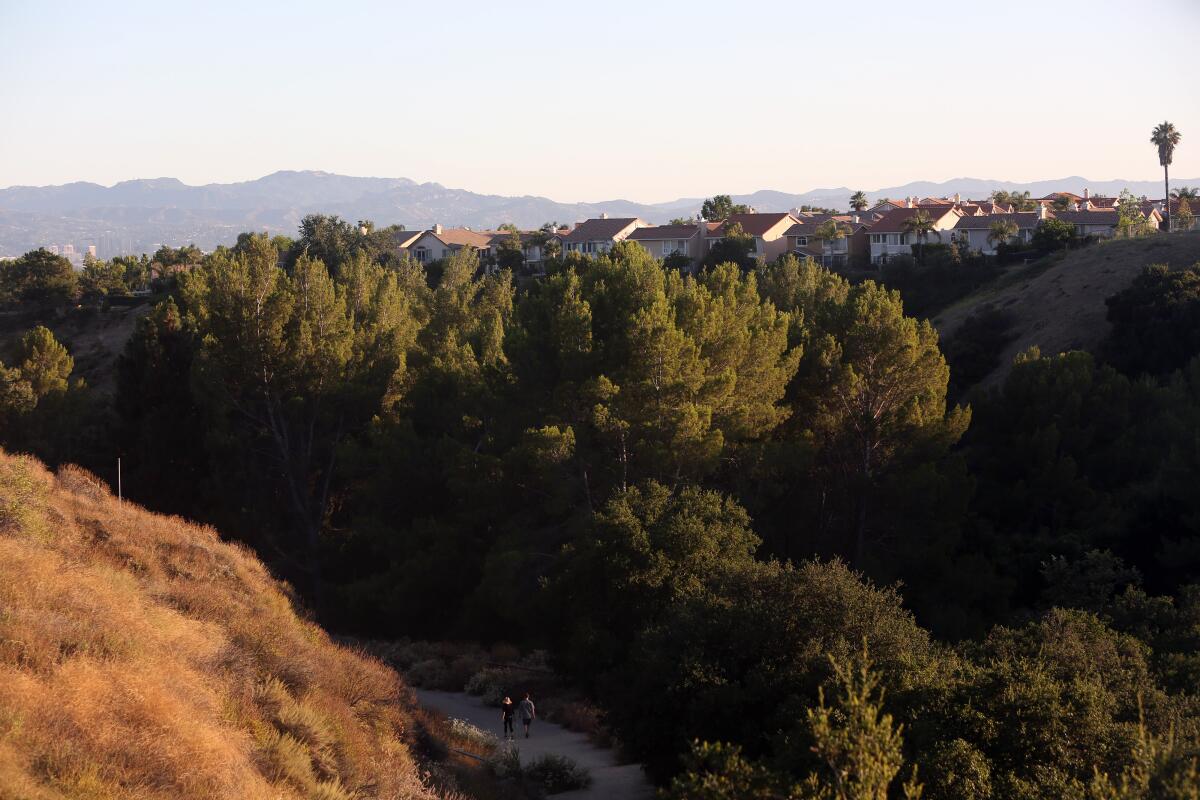
(Dania Maxwell/Los Angeles Times)
Limekiln Canyon Park is an unexpected delight in an unlikely place: a raw, natural, open space in the midst of highly manicured gated housing developments in Northridge. Shady, lush and likely to have running water much of the year, it feels surprisingly remote for a location so close to civilization.
Though it’s naturally shaded, go early in the day, especially in summer before the heat picks up. Start near the intersection of Rinaldi Street and Tampa Avenue near the park entrance and begin walking downhill on a broad path, past a grassy field and under the shade of oak, pine and even a few redwood trees. (Note the warning about rattlesnakes: another reason to keep your dog on a leash.) At the first Y intersection, just before you reach a creek on your left, leave the wide trail for a narrower one heading up to the right. Walk on, keeping the creek on your left.
In the streambed, note the sycamore and willow trees, interrupted by the occasional incongruous fan palm. At the next Y, head right and climb a short, steep bit of trail to a wider trail. (Or go straight ahead at the bottom of this climb to check on a shady spot with a rope swing over the creek.)
Continue along this flat trail, which is paved in places, leaving the streambed far below you as it passes under Hollow Springs Drive. Walk on as the trail rises and falls, sometimes running close to the stream down to the left, sometimes close to Tampa Avenue up to the right. In a little less than two miles, the wide, flat trail suddenly ends.
Two spur trails rise up to Sesnon Boulevard, and more trails continue on the other side, but this is the end of the line for this walk. Turn around and head back downhill, staying on the unpaved narrow trail to the right wherever there is a Y intersection with a paved road going to the left. (These will lead up to Tampa Avenue.) Near the bottom, bear right at one last Y intersection and cross a wide meadow shaded by tall pine trees. Then turn left and make a water crossing — the creek you skipped at the beginning of the walk — to return to the main trail, under those redwoods, and the way back to your starting point on Rinaldi.
Park on the street near the Rinaldi Street entrance. Here are more shady places in L.A. to explore.
Though it’s naturally shaded, go early in the day, especially in summer before the heat picks up. Start near the intersection of Rinaldi Street and Tampa Avenue near the park entrance and begin walking downhill on a broad path, past a grassy field and under the shade of oak, pine and even a few redwood trees. (Note the warning about rattlesnakes: another reason to keep your dog on a leash.) At the first Y intersection, just before you reach a creek on your left, leave the wide trail for a narrower one heading up to the right. Walk on, keeping the creek on your left.
In the streambed, note the sycamore and willow trees, interrupted by the occasional incongruous fan palm. At the next Y, head right and climb a short, steep bit of trail to a wider trail. (Or go straight ahead at the bottom of this climb to check on a shady spot with a rope swing over the creek.)
Continue along this flat trail, which is paved in places, leaving the streambed far below you as it passes under Hollow Springs Drive. Walk on as the trail rises and falls, sometimes running close to the stream down to the left, sometimes close to Tampa Avenue up to the right. In a little less than two miles, the wide, flat trail suddenly ends.
Two spur trails rise up to Sesnon Boulevard, and more trails continue on the other side, but this is the end of the line for this walk. Turn around and head back downhill, staying on the unpaved narrow trail to the right wherever there is a Y intersection with a paved road going to the left. (These will lead up to Tampa Avenue.) Near the bottom, bear right at one last Y intersection and cross a wide meadow shaded by tall pine trees. Then turn left and make a water crossing — the creek you skipped at the beginning of the walk — to return to the main trail, under those redwoods, and the way back to your starting point on Rinaldi.
Park on the street near the Rinaldi Street entrance. Here are more shady places in L.A. to explore.
Show more Show less
Route Details
El Dorado Nature Center
Urban Trail
2.25-mile loop
Easy
About 50 to 100 feet
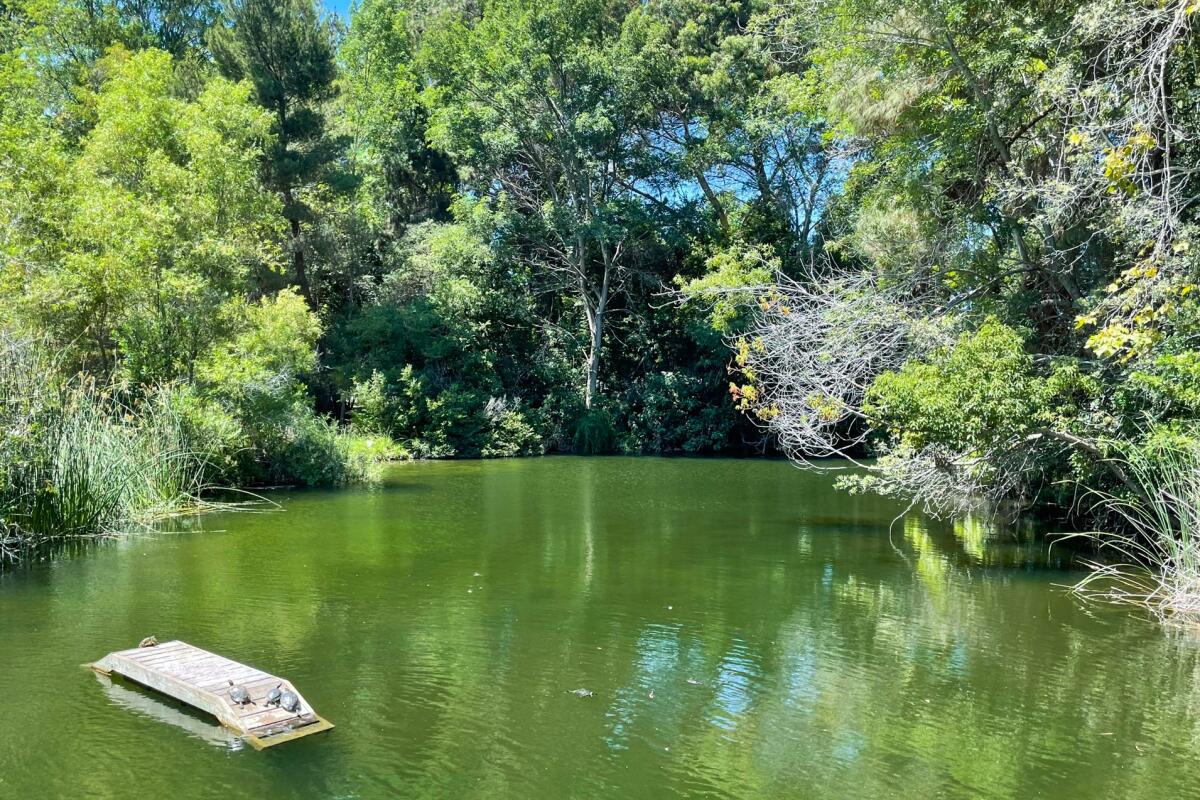
(Mary Forgione / Los Angeles Times)
The El Dorado Nature Center in Long Beach is a park within a park. Native oak trees are your friends on the trails in the 105-acre sanctuary. Enter on the flat paved trail and almost immediately you come to tree-fringed North Lake, where turtles and birds sun themselves. Paths are well marked, with simple wooden benches under the trees.
Choose an easy quarter-mile trail through the trees or bear left to find one- or two-mile routes. The one-miler crosses the creek and winds gently uphill through an oak-filled spot nicknamed Squirrel Hill (lots of signs about not feeding them); the two-mile trail swings out to a second body of water, South Lake, before looping back to the main trail. It’s a lovely, cool refuge on a hot day but not always silent.
You can hear the distant hum of freeways (the 605 and 405 are nearby) and sometimes the screeches of school kids who visit by the busload. Still, none of this undermines the cool-down effect on super-heated days. After your hike, explore surrounding El Dorado East Regional Park, which has a dog park, more lakes and shaded places to seek out on a hot day.
The trails are open 8 a.m. to 5 p.m. (no entry after 4:30 p.m.); parking costs $6 to $9 per vehicle. Find more information about the El Dorado Nature Center here and check out the 50 best hikes in L.A.
Choose an easy quarter-mile trail through the trees or bear left to find one- or two-mile routes. The one-miler crosses the creek and winds gently uphill through an oak-filled spot nicknamed Squirrel Hill (lots of signs about not feeding them); the two-mile trail swings out to a second body of water, South Lake, before looping back to the main trail. It’s a lovely, cool refuge on a hot day but not always silent.
You can hear the distant hum of freeways (the 605 and 405 are nearby) and sometimes the screeches of school kids who visit by the busload. Still, none of this undermines the cool-down effect on super-heated days. After your hike, explore surrounding El Dorado East Regional Park, which has a dog park, more lakes and shaded places to seek out on a hot day.
The trails are open 8 a.m. to 5 p.m. (no entry after 4:30 p.m.); parking costs $6 to $9 per vehicle. Find more information about the El Dorado Nature Center here and check out the 50 best hikes in L.A.
Show more Show less
Route Details
Carbon Canyon Regional Park, Brea
Urban Trail
2.0-mile loop
Easy
100 feet

(Matt Pawlik)
Would you believe it if someone told you that you could find some of the tallest trees on Earth hidden in Orange County? Head to Carbon Canyon Regional Park in Brea to see for yourself by taking a two-mile loop through the 124-acre green space that includes recreational amenities and a serene lake.
The wide dirt path of the nature trail is well-marked throughout and meanders through dense shrubs and walnut trees (listen for resident towhees) before depositing you under the giant arboreal wonders after just half a mile. The grove of 241 coastal redwoods, the product of a local bank’s seedling promotion in the 1970s, is the largest of its kind in Southern California.
Interpretive signs detail their history, including the efforts of park rangers to preserve them despite Southern California’s arid climate. Among the nearly 100-foot Sequoia sempervirens specimens, you’ll notice the temperature drop more than 10 degrees (as if you need another reason to go). Before heading back, climb the steep trail at the southwestern corner for sweeping views that look down on the grove, as well as hulking Carbon Canyon Dam and the surrounding town of Brea.
Park in dirt or paved lots ($3 weekdays, $5 weekends); dog-friendly. Start at the nature trail from the south parking lot.
The wide dirt path of the nature trail is well-marked throughout and meanders through dense shrubs and walnut trees (listen for resident towhees) before depositing you under the giant arboreal wonders after just half a mile. The grove of 241 coastal redwoods, the product of a local bank’s seedling promotion in the 1970s, is the largest of its kind in Southern California.
Interpretive signs detail their history, including the efforts of park rangers to preserve them despite Southern California’s arid climate. Among the nearly 100-foot Sequoia sempervirens specimens, you’ll notice the temperature drop more than 10 degrees (as if you need another reason to go). Before heading back, climb the steep trail at the southwestern corner for sweeping views that look down on the grove, as well as hulking Carbon Canyon Dam and the surrounding town of Brea.
Park in dirt or paved lots ($3 weekdays, $5 weekends); dog-friendly. Start at the nature trail from the south parking lot.
Show more Show less
Route Details
George F Canyon Preserve
Rolling Hills Estates Canyon Trail
1.8-mile out-and-back
Easy
331 feet of gain
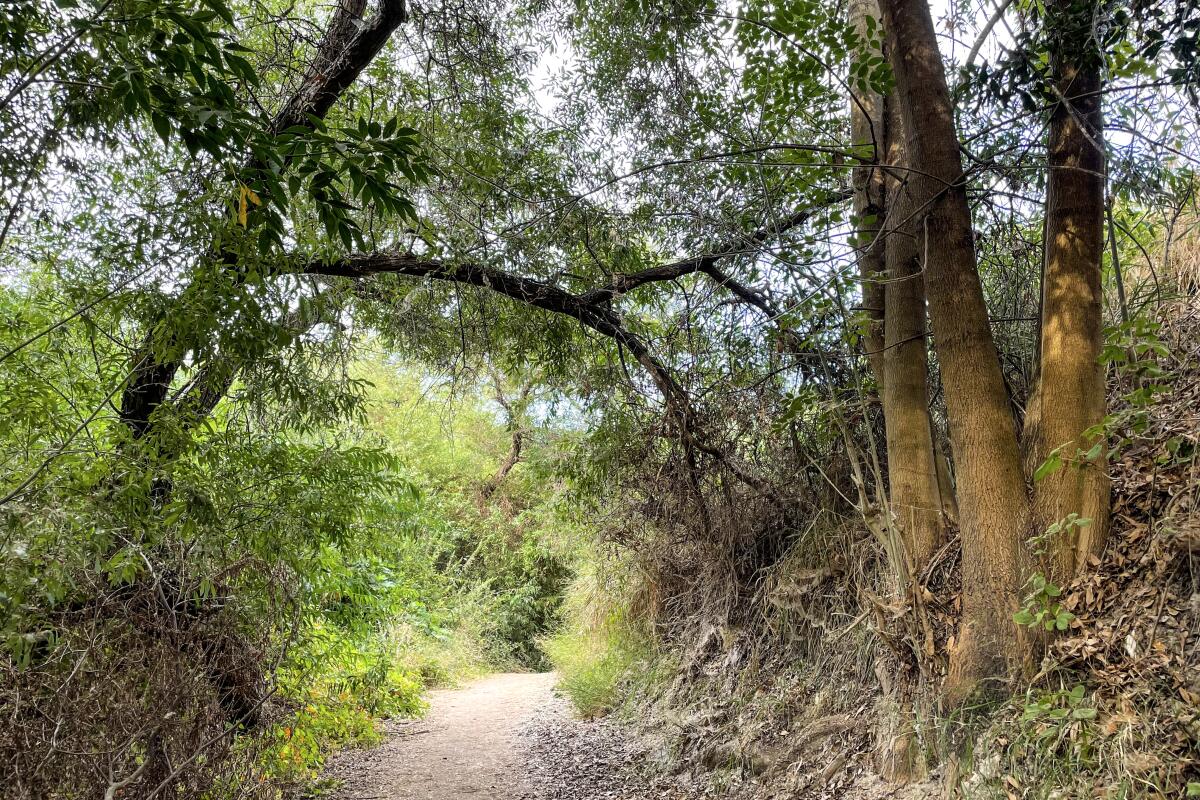
(Mary Forgione / Los Angeles Times)
The George F Canyon Nature Trail in Rolling Hills Estates is shaded at the start by willows that later give way to lemonadeberry, sage, buckwheat and sagebrush. The narrow canyon climbs gently to a high point of 620 feet. The guide to the Stein-Hale Nature Trail (named for the families that sold the land to the city) explains the significance of a dozen numbered stops. Look for birds at an observation deck at No. 3; spot the oldest rock (Catalina schist) on the Palos Verdes Peninsula at No. 7; rest on a bench under the shade of a Catalina cherry tree at No. 9; and savor the views at a lookout beneath an elderberry tree at No. 12. It’s an easy hike good for beginners and young children. It’s also a sweet spot to get a sense of what the peninsula looked like when the native Tongva people lived here. Take your time as you climb — and take advantage of the benches along the way. Start outside the nature center, where a small connector path takes you to the main out-and-back trail. Park for free at the George F Nature Canyon Nature Center.
Show more Show less
Route Details
Icehouse Saddle
Mountain Trail
7.2-mile out-and-back
Strenuous
2,600 feet
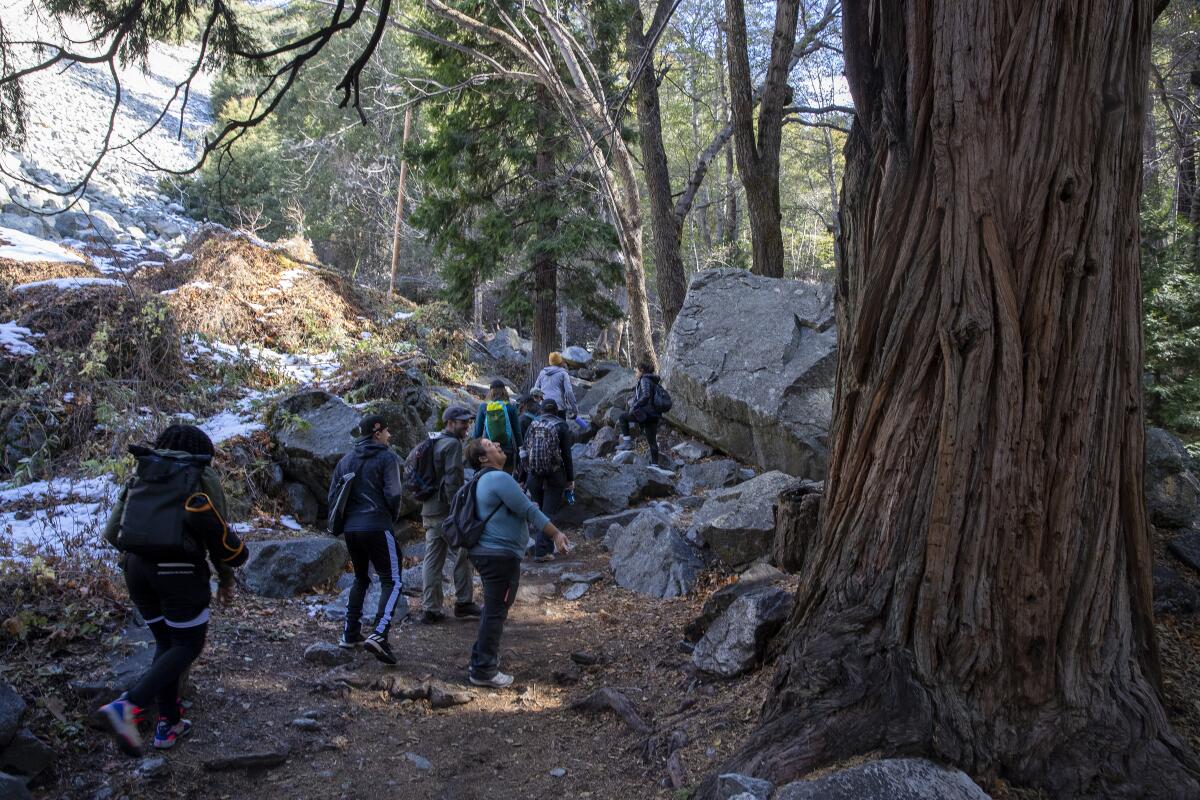
(Brian van der Brug / Los Angeles Times)
Icehouse Canyon near Mt. Baldy Village is a stunning canyon shaded by sycamores, cedars and pines. It’s part of the Cucamonga Wilderness, an alpine route that includes access to many high-elevation peaks. Take the main Icehouse Canyon Trail that starts along a tree-lined creek where people dip their feet (or more) to escape summer heat. Stop anywhere along the way to take a break by the water; you may not want to leave.
The trail pushes on past rustic cabins and, in spring and summer, columbine and scarlet monkey flowers bloom at watery seeps. You’re hiking uphill the whole time. Halfway up, long switchbacks require serious leg work as the trail zigzags toward the saddle at 7,500 feet. Pull up a log, bask in the shade and have lunch or a snack.
For those who want to hike longer and higher, continue from the saddle on well-marked routes to Ontario, Cucamonga and Timber (shown in the photo above) peaks. On the way down, stop at the creek to double down on the cool factor. One caveat: Parking is brutal on weekends. When the lot is full, you’ll have to find a spot on the narrow Mt. Baldy Road. Also, a U.S. Forest Adventure Pass ($5) is required.
The trail pushes on past rustic cabins and, in spring and summer, columbine and scarlet monkey flowers bloom at watery seeps. You’re hiking uphill the whole time. Halfway up, long switchbacks require serious leg work as the trail zigzags toward the saddle at 7,500 feet. Pull up a log, bask in the shade and have lunch or a snack.
For those who want to hike longer and higher, continue from the saddle on well-marked routes to Ontario, Cucamonga and Timber (shown in the photo above) peaks. On the way down, stop at the creek to double down on the cool factor. One caveat: Parking is brutal on weekends. When the lot is full, you’ll have to find a spot on the narrow Mt. Baldy Road. Also, a U.S. Forest Adventure Pass ($5) is required.
Show more Show less
Route Details
Switzer Falls
Los Angeles County Mountain Trail
3.7-mile out-and-back
Moderate
700 feet
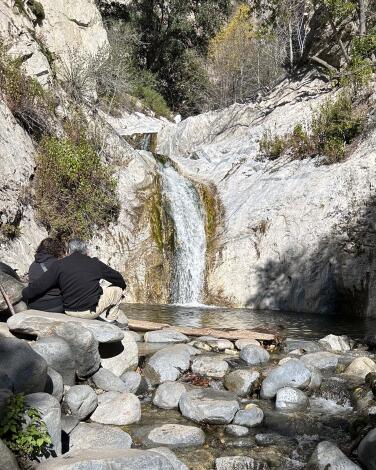
(Matt Pawlik / Los Angeles Times)
Water, water, water. It’s the most sought-after item on a Southern California hike, whether it’s bottled in your pack or streaming down a hillside. The waterfalls in the front range of the Angeles National Forest are popular (code for “expect big crowds, especially on hot weekends”), but that’s no reason to avoid them.
The site was one of the first mountain resorts to open to “tourist hikers” in 1884, and it’s easy to see why. The downhill hike takes you to the top of the falls and then into cool Bear Canyon. Refresh yourself at the 50-foot lower falls and maybe swim in its pool (the upper falls are hard to access on a sketchy route). Hang out by the water or in one of the shady picnic areas along the way. The way out is the same — only uphill. Go early to snag a parking spot and beat the hordes.
Park and start at the Switzer Picnic Area on Angeles Crest Highway about 10 miles north of La Cañada Flintridge. Directions to trailhead.
The site was one of the first mountain resorts to open to “tourist hikers” in 1884, and it’s easy to see why. The downhill hike takes you to the top of the falls and then into cool Bear Canyon. Refresh yourself at the 50-foot lower falls and maybe swim in its pool (the upper falls are hard to access on a sketchy route). Hang out by the water or in one of the shady picnic areas along the way. The way out is the same — only uphill. Go early to snag a parking spot and beat the hordes.
Park and start at the Switzer Picnic Area on Angeles Crest Highway about 10 miles north of La Cañada Flintridge. Directions to trailhead.
Show more Show less
Route Details
Century Lake Dam
3.0-mile out-and-back
Easy
Less than 1,000 feet

(Mary Forgione / Los Angeles Times)
Even on sweltering days, Malibu Creek State Park has you covered. Century Lake Dam in the Santa Monica Mountains southwest of Calabasas is a worthy beat-the-heat destination. It’s not a natural water hole, but the shady path down to the lake and its incomparable big-rock vistas are the real deal — and oh so soothing. The dam was built in 1903 to create a duck pond for a posh country club for wealthy Angelenos. It flourished for a while but eventually went belly up. In 1946, 20th Century Fox Studios bought the lake and a big swath of land to film movies such as “Planet of the Apes” in 1968 and others, hence the name.
Start in the parking lot and take the dirt trail, which is wide enough to accommodate hikers, horseback riders, trail runners and mountain bikers without anyone getting cranky about their space. It parallels the creek (which, depending on when you go, may be dry in places) under canopy oaks that frame the craggy rock formations that made the park a movie-maker’s dream.
Follow signs to Crags Road, and, after an exposed uphill stretch, you’ll see a marked turnoff to the lake on the left. You can dive in (here and at the nearby Rock Pools) and snack at a lakeside picnic table. Want to go farther? Another mile on Crags Road leads to a single-track trail and old vehicles from the “MASH” TV show from the 1970s and ‘80s.
Enter off Las Virgenes Road and park ($12 for the day).
Start in the parking lot and take the dirt trail, which is wide enough to accommodate hikers, horseback riders, trail runners and mountain bikers without anyone getting cranky about their space. It parallels the creek (which, depending on when you go, may be dry in places) under canopy oaks that frame the craggy rock formations that made the park a movie-maker’s dream.
Follow signs to Crags Road, and, after an exposed uphill stretch, you’ll see a marked turnoff to the lake on the left. You can dive in (here and at the nearby Rock Pools) and snack at a lakeside picnic table. Want to go farther? Another mile on Crags Road leads to a single-track trail and old vehicles from the “MASH” TV show from the 1970s and ‘80s.
Enter off Las Virgenes Road and park ($12 for the day).
Show more Show less
Route Details
Oakwilde (Gabrielino Trail)
Urban Trail
10.0-mile out-and-back
Moderate
Less than 1,000 feet of gain
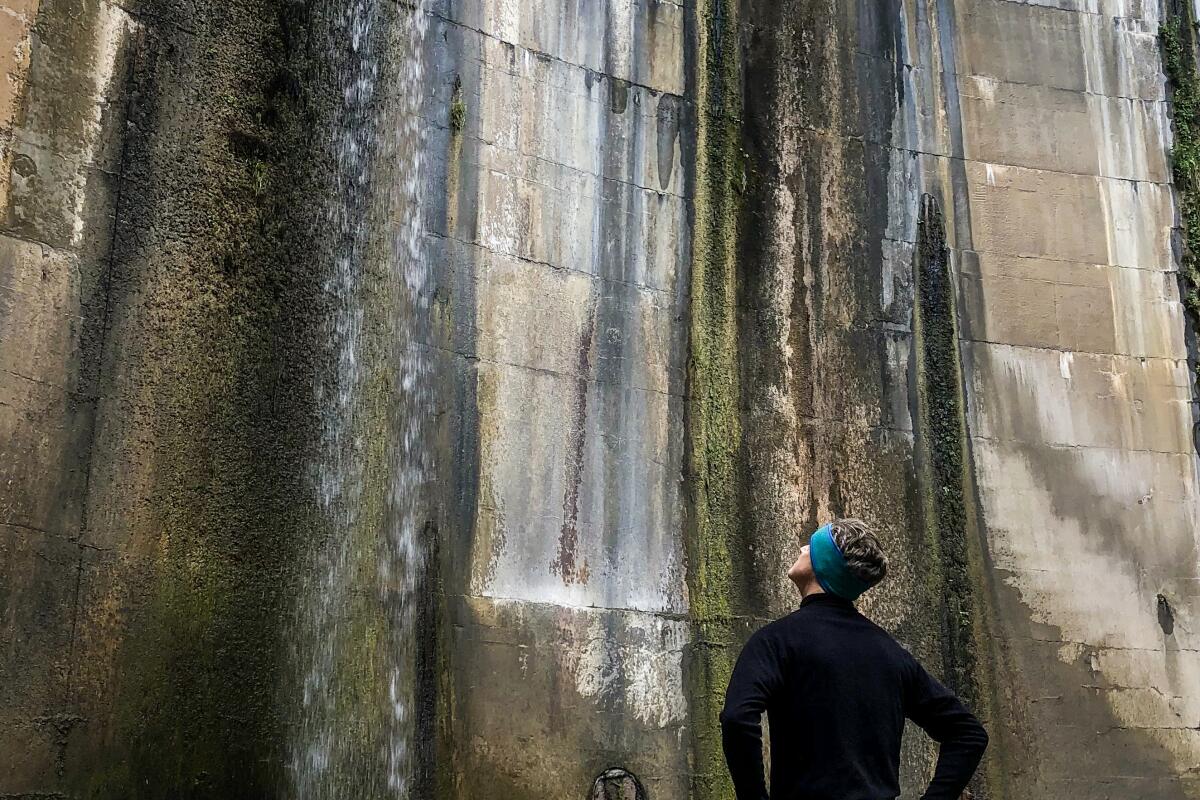
(Siena Giljum)
Besides the shade you’ll enjoy along this nearly 10-mile trail sandwiched between Altadena and La Cañada Flintridge, you’ll encounter water features that usually have at least a trickle, even in a drought. Pass the Jet Propulsion Lab campus and trek into Angeles National Forest, shaded all the while by mature oaks, pines, firs and walnut trees. The relatively flat trail offers a great workout because of its length — but it’s not one that will have you in a puddle from the heat. You can cool off at the U.S. Forest Service dam at the end, where hikers take a dip or refuel with a packed lunch (or fruit with limón and Tajín from the vendor sometimes set up near the entrance).
Enter on Ventura and Windsor streets in Altadena, then head out on an asphalt path past a yellow gate and fire danger sign. Free street parking.
Enter on Ventura and Windsor streets in Altadena, then head out on an asphalt path past a yellow gate and fire danger sign. Free street parking.
Show more Show less
Route Details
Michael D. Antonovich Trail, Walnut Creek Community Regional Park
San Dimas Canyon Trail
7.8-mile out-and-back
Moderate
400
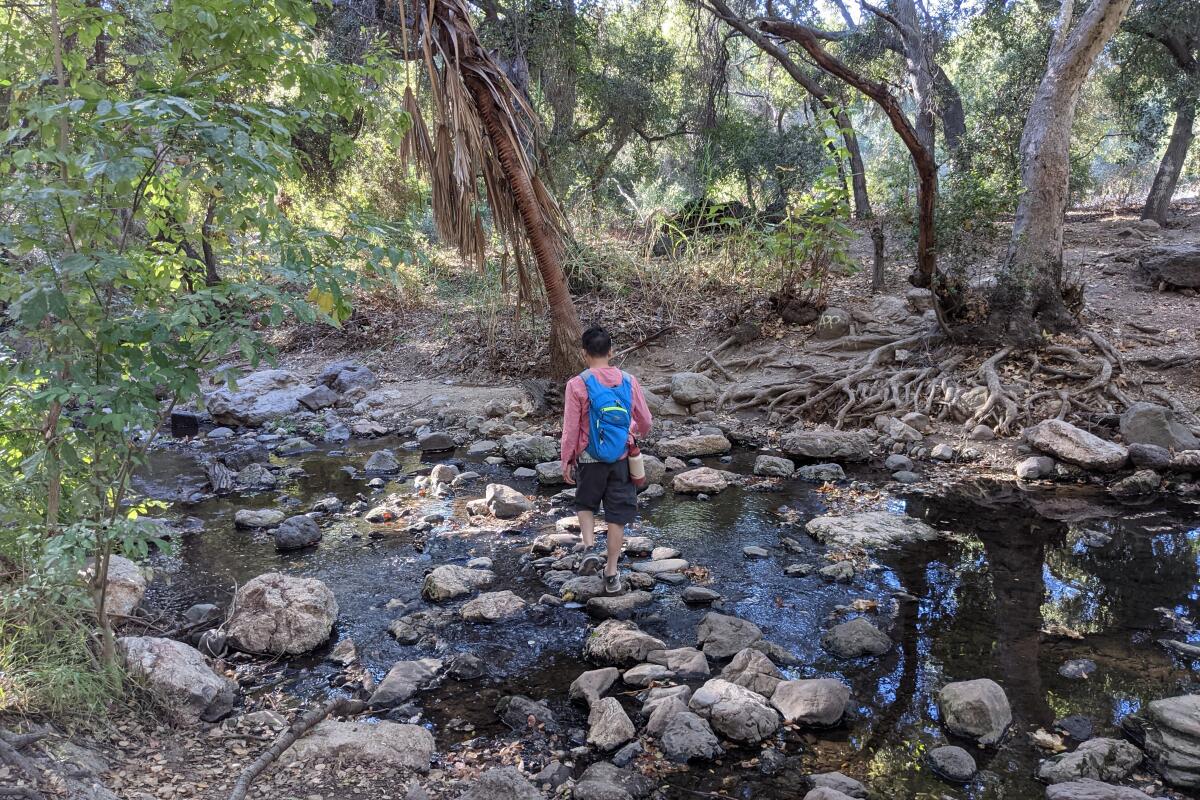
(Matt Pawlik)
“Peace is every step.” The oft-quoted Buddhist Thich Nhat Hanh talked about a figurative path to mindfulness, but sometimes a literal approach is the best remedy to find true tranquillity. Nestled among the busy freeway intersections of eastern San Gabriel Valley’s San Dimas is the Michael D. Antonovich Trail, a gentle and heavily-shaded 7.6-mile out-and-back that’s perfect for anyone seeking some weekend solace.
Throughout your peaceful trek, you will be paralleling the babbling waters of Walnut Creek and so you will encounter multiple stream crossings. Among the riparian environment, many types of flora will be present, such as the giant green leaves of palms and ferns, but you will also have good opportunities for meeting some resident wildlife visiting the creek. Look for herons and egrets who love to hunt along the shore during sunrise and sunset.
You’ll also pass a campground, multiple trail entry points and the entrance to a local Buddhist temple, the Tzu Chi Foundation, which welcomes visitors. The trail ends at a connection with Oak Canyon Road, or you can head back the way you came at any point.
Park at the free lot along San Dimas Avenue. Dog friendly.
Throughout your peaceful trek, you will be paralleling the babbling waters of Walnut Creek and so you will encounter multiple stream crossings. Among the riparian environment, many types of flora will be present, such as the giant green leaves of palms and ferns, but you will also have good opportunities for meeting some resident wildlife visiting the creek. Look for herons and egrets who love to hunt along the shore during sunrise and sunset.
You’ll also pass a campground, multiple trail entry points and the entrance to a local Buddhist temple, the Tzu Chi Foundation, which welcomes visitors. The trail ends at a connection with Oak Canyon Road, or you can head back the way you came at any point.
Park at the free lot along San Dimas Avenue. Dog friendly.
Show more Show less
Route Details
Franklin Canyon Park
Beverly Crest Canyon Trail
2.0-mile loop
Easy

(Matt Pawlik)
When the sun is out but you don’t want to stay in, opt for a short, shady hike in one of Tinseltown’s many secret canyons. Enter Franklin Canyon Park, a 605-acre fairytale setting hidden between Beverly Hills and the San Fernando Valley.
Head to the Upper Franklin Canyon Reservoir to start your serene loop. The path winds under sycamores, pines, palms, oaks and even redwoods as it flanks the peaceful reservoir, which often has resident ducks, coots and other waterfowl floating across the gentle water. After crossing a footbridge, you’ll reach the southern end of the reservoir — a lovely place to picnic.
After reaching a parking lot at Franklin Canyon Drive (the southern tip of your loop), find a concrete trail heading north across the road. This less-visited segment meanders along the canyon walls amid chaparral classics, including a dense collection of rosemary bushes. Scan the trailside for the gorgeous purple blooms of bigleaf periwinkle and the unique hanging red flowers of fuchsia gooseberries. The vistas of this secluded canyon are great throughout this portion of the hike, and you can even spot the small Turtle Pond below, in addition to the namesake reservoir.
Park at the free lot next to the Sooky Goldman Nature Center, which has some exhibits and a charming amphitheater. Dog friendly.
Head to the Upper Franklin Canyon Reservoir to start your serene loop. The path winds under sycamores, pines, palms, oaks and even redwoods as it flanks the peaceful reservoir, which often has resident ducks, coots and other waterfowl floating across the gentle water. After crossing a footbridge, you’ll reach the southern end of the reservoir — a lovely place to picnic.
After reaching a parking lot at Franklin Canyon Drive (the southern tip of your loop), find a concrete trail heading north across the road. This less-visited segment meanders along the canyon walls amid chaparral classics, including a dense collection of rosemary bushes. Scan the trailside for the gorgeous purple blooms of bigleaf periwinkle and the unique hanging red flowers of fuchsia gooseberries. The vistas of this secluded canyon are great throughout this portion of the hike, and you can even spot the small Turtle Pond below, in addition to the namesake reservoir.
Park at the free lot next to the Sooky Goldman Nature Center, which has some exhibits and a charming amphitheater. Dog friendly.
Show more Show less
Route Details
Millard Canyon
Altadena Mountain Trail
1.5-mile out-and-back
Easy
200
Lace up the waterproof boots for this short hike to one sweet waterfall. This 50-footer is an iconic canyon feature of the Angeles National Forest and is especially mesmerizing after heavy rain. It’s also situated in a shaded canyon in the foothills of the San Gabriels, making for a perfect summer trek.
Your stunning canyon adventure begins near a charming six-site campground, with towering ancient live oaks and a flowing stream that parallels the trail. You will enjoy plenty of stream-hopping opportunities across boulders and logs — I recommend taking a dip in the rock pool under the roaring falls after your picturesque, shaded ravine exploration. Tip: You can extend your trip with a 5-mile loop along the Sunset Ridge Trail to the historic ruins of Dawn Mine, if you’re up for the 1,500 feet of elevation gain.
Find street parking along Chaney Trail. Dog friendly.
Your stunning canyon adventure begins near a charming six-site campground, with towering ancient live oaks and a flowing stream that parallels the trail. You will enjoy plenty of stream-hopping opportunities across boulders and logs — I recommend taking a dip in the rock pool under the roaring falls after your picturesque, shaded ravine exploration. Tip: You can extend your trip with a 5-mile loop along the Sunset Ridge Trail to the historic ruins of Dawn Mine, if you’re up for the 1,500 feet of elevation gain.
Find street parking along Chaney Trail. Dog friendly.
Show more Show less
Route Details
Heaps Peak Arboretum
Forest Trail
1.0-mile loop
Easy
Less than 100
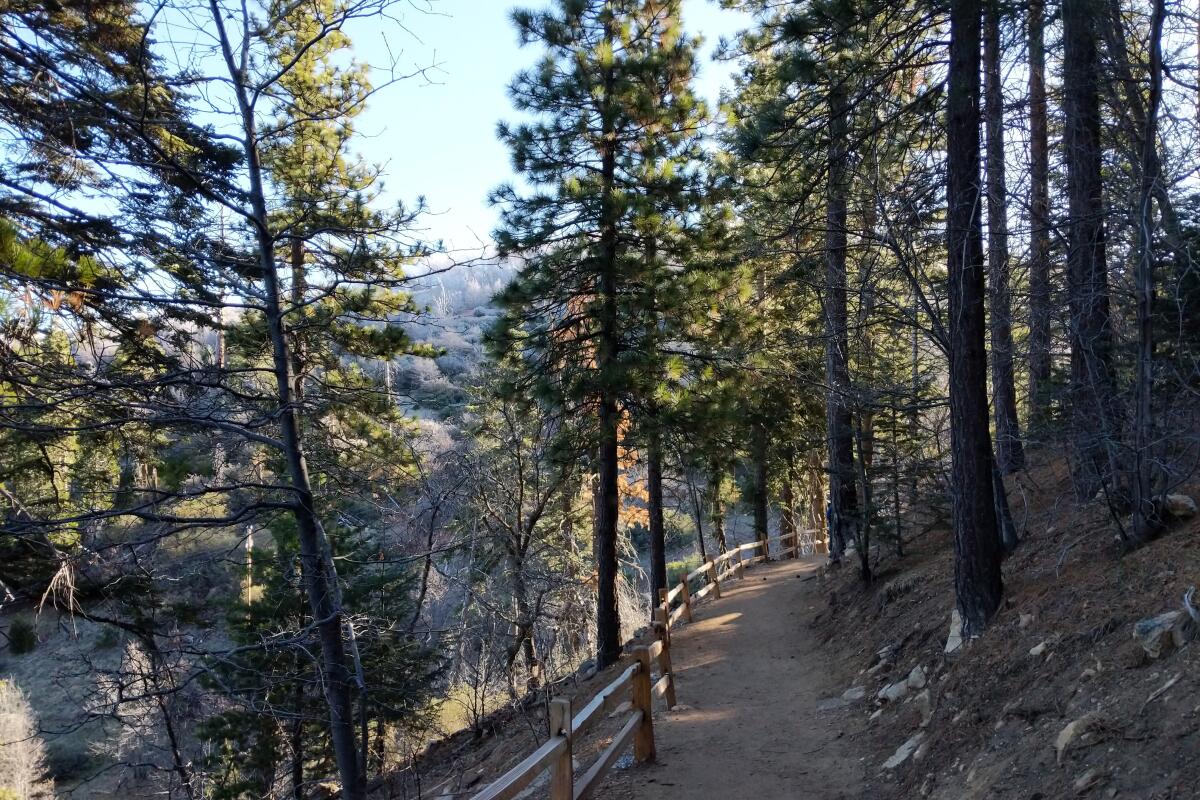
(Matt Pawlik)
Need shade? Why not look to some of the biggest trees on earth? Though small in acreage, Heaps Peak Arboretum in Skyforest has a stellar collection of massive trees, including giant sequoias.
Sitting at over 6,000 feet elevation in the San Bernardino National Forest, the arboretum is also home to impressive specimens of incense cedar, black oak, white fir and sugar pine. On the Sequoia Trail, which leads you through those arboreal wonders, you’ll find a charming footbridge over a creek and plenty of shade. Yet the showstoppers are the sequoias, planted in the 1930s and found in the Ann Henck Stewart Memorial Sequoia Grove. Though these sequoias are smaller than their Northern California counterparts like the General Sherman in Sequoia National Park, you’ll still want to stop and bask in their glory.
Park in the paved lot (Adventure Pass required). Dog friendly.
Sitting at over 6,000 feet elevation in the San Bernardino National Forest, the arboretum is also home to impressive specimens of incense cedar, black oak, white fir and sugar pine. On the Sequoia Trail, which leads you through those arboreal wonders, you’ll find a charming footbridge over a creek and plenty of shade. Yet the showstoppers are the sequoias, planted in the 1930s and found in the Ann Henck Stewart Memorial Sequoia Grove. Though these sequoias are smaller than their Northern California counterparts like the General Sherman in Sequoia National Park, you’ll still want to stop and bask in their glory.
Park in the paved lot (Adventure Pass required). Dog friendly.
Show more Show less
Route Details
No matching entries.
Please reset filters to see all entries.
No matching entries.
Please reset filters to see all entries.
Top



